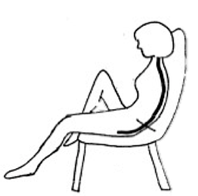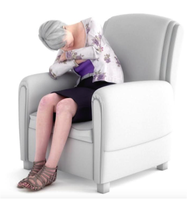 Seating people comfortably Many elderly and disabled people in care sit for long periods of time. Some are able to move themselves while others are not able to move without assistance. For those of us caring for the elderly and disabled we need to think carefully about how we seat those in our care. We need to consider things like:
Good posture is important to prevent back pain, encourage mobility, assist swallowing and prevent chest infections. When choosing a chair for a client it needs to be supportive to prevent them from slumping over. When sitting for long periods of time without being able to adjust your position, circulation to areas on a person’s bottom, legs and back can be cut off causing discomfort and, if left, pressure sores. When sitting for long periods of time without being able to adjust your position, circulation to areas on a person’s bottom, legs and back can be cut off causing discomfort and, if left, pressure sores.  Pressure relief is important. Some chairs have pressure relief features built into them; we recommend these, especially for people who are unable to change their position. Alternatively pressure cushions can be used. Air filled pressure cushions (Rohos) can be problematic. They can be slippery causing a person to slide forward into a slumped posture. A slumped posture is uncomfortable, can make it hard to swallow and breathe effectively and take part in activities. The cushions raise the height of the seat, which may cause the feet to dangle, leading to discomfort under the thighs. While sitting it’s important to have feet on the floor or a footrest. For more information on pressure injuries follow this link. https://www.therapyprofessionals.co.nz/uploads/4/9/5/2/49523375/skin_injuries_caused_by_pressure.pdf Keeping people mobile as long as possible is in everyone’s best interests. If you are caring for someone who can still stand themselves up or better still walk safely, it’s important you choose a seat that encourages them to stand and get out of easily. This means their feet must be flat on the floor, the chair has armrests at the right height to push up from and the seat surface is firm enough to wriggle forward.  The ideal seat for a person, maintains an upright posture with their bottom back in the chair and hips at a 90 degree angle. The chair needs to support the spine, thighs with a gap behind the knees and the armrests should support the arms with relaxed shoulders. Feet need to be flat on the floor or supported on a footstool. For more information on choosing a seat follow this link https://www.therapyprofessionals.co.nz/uploads/4/9/5/2/49523375/choosing_a_comfy_armchair__.pdf
If you need some help seating the elderly or disabled in your care our friendly Physiotherapists and Occupational Therapists can help just contact us at Therapy Professionals. Ph: 03 3775280 Email: [email protected] Comments are closed.
|
AuthorShonagh O'Hagan Archives
July 2024
|

 RSS Feed
RSS Feed